CCNA 1 v6 - Chapter 4 Exam Answers 2019 – 100% Full

1. What are two reasons for physical layer protocols to use frame encoding techniques? (Choose two.)
- to reduce the number of collisions on the media
- to distinguish data bits from control bits*
- to provide better media error correction
- to identify where the frame starts and ends*
- to increase the media throughput
- to distinguish data from control information
2. What is indicated by the term throughput?
- the guaranteed data transfer rate offered by an ISP
- the capacity of a particular medium to carry data
- the measure of the usable data transferred across the media
- the measure of the bits transferred across the media over a given period of time*
- the time it takes for a message to get from sender to receiver
3. A network administrator notices that some newly installed Ethernet cabling is carrying corrupt and distorted data signals. The new cabling was installed in the ceiling close to fluorescent lights and electrical equipment. Which two factors may interfere with the copper cabling and result in signal distortion and data corruption? (Choose two.)
- EMI*
- crosstalk
- RFI*
- signal attenuation
- extended length of cabling
4. Which characteristic describes crosstalk?
- the distortion of the network signal from fluorescent lighting
- the distortion of the transmitted messages from signals carried in adjacent wires*
- the weakening of the network signal over long cable lengths
- the loss of wireless signal over excessive distance from the access point
5. What technique is used with UTP cable to help protect against signal interference from crosstalk?
- twisting the wires together into pairs*
- wrapping a foil shield around the wire pairs
- encasing the cables within a flexible plastic sheath
- terminating the cable with special grounded connectors
6. Refer to the exhibit. The PC is connected to the console port of the switch. All the other connections are made through FastEthernet links. Which types of UTP cables can be used to connect the devices?


- 1 – rollover, 2 – crossover, 3 – straight-through
- 1 – rollover, 2 – straight-through, 3 – crossover*
- 1 – crossover, 2 – straight-through, 3 – rollover
- 1 – crossover, 2 – rollover, 3 – straight-through
7. Refer to the exhibit. What is wrong with the displayed termination?


- The woven copper braid should not have been removed.
- The wrong type of connector is being used.
- The untwisted length of each wire is too long.*
- The wires are too thick for the connector that is used.
8. Which type of connector does a network interface card use?
- DIN
- PS-2
- RJ-11
- RJ-45*
9. What is one advantage of using fiber optic cabling rather than copper cabling?
- It is usually cheaper than copper cabling.
- It is able to be installed around sharp bends.
- It is easier to terminate and install than copper cabling.
- It is able to carry signals much farther than copper cabling.*
10. Why are two strands of fiber used for a single fiber optic connection?
- The two strands allow the data to travel for longer distances without degrading.
- They prevent crosstalk from causing interference on the connection.
- They increase the speed at which the data can travel.
- They allow for full-duplex connectivity.*
11. A network administrator is designing the layout of a new wireless network. Which three areas of concern should be accounted for when building a wireless network? (Choose three.)
- mobility options
- security *
- interference *
- coverage area*
- extensive cabling
- packet collision
12. Which layer of the OSI model is responsible for specifying the encapsulation method used for specific types of media?
- application
- transport
- data link*
- physical
13. What are two services performed by the data link layer of the OSI model? (Choose two.)
- It encrypts data packets.
- It determines the path to forward packets.
- It accepts Layer 3 packets and encapsulates them into frames. *
- It provides media access control and performs error detection.*
- It monitors the Layer 2 communication by building a MAC address table.
14. What is true concerning physical and logical topologies?
- The logical topology is always the same as the physical topology.
- Physical topologies are concerned with how a network transfers frames.
- Physical topologies display the IP addressing scheme of each network.
- Logical topologies refer to how a network transfers data between devices.*
15. Which method of data transfer allows information to be sent and received at the same time?
- full duplex*
- half duplex
- multiplex
- simplex
16. Which statement describes an extended star topology?
- End devices connect to a central intermediate device, which in turn connects to other central intermediate devices.*
- End devices are connected together by a bus and each bus connects to a central intermediate device.
- Each end system is connected to its respective neighbor via an intermediate device.
- All end and intermediate devices are connected in a chain to each other.
17. Refer to the exhibit. Which statement describes the media access control methods that are used by the networks in the exhibit?
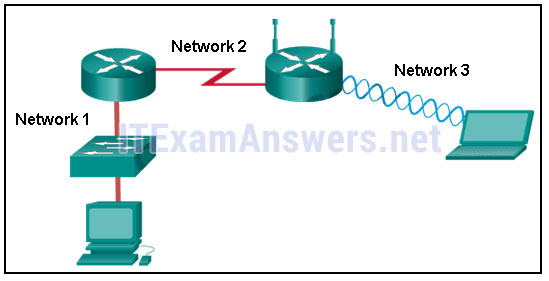

- All three networks use CSMA/CA
- None of the networks require media access control.
- Network 1 uses CSMA/CD and Network 3 uses CSMA/CA.*
- Network 1 uses CSMA/CA and Network 2 uses CSMA/CD.
- Network 2 uses CSMA/CA and Network 3 uses CSMA/CD.
18. What is contained in the trailer of a data-link frame?
- logical address
- physical address
- data
- error detection*
19. As data travels on the media in a stream of 1s and 0s how does a receiving node identify the beginning and end of a frame?
- The transmitting node inserts start and stop bits into the frame.*
- The transmitting node sends a beacon to notify that a data frame is attached.
- The receiving node identifies the beginning of a frame by seeing a physical address.
- The transmitting node sends an out-of-band signal to the receiver about the beginning of the frame.
20. What is a role of the Logical Link Control sublayer?
- to provide data link layer addressing
- to provide access to various Layer 1 network technologies
- to define the media access processes performed by network hardware
- to mark frames to identify the network layer protocol being carried*
21. What is the definition of bandwidth?
- the measure of usable data transferred over a given period of time
- the speed at which bits travel on the network
- the measure of the transfer of bits across the media over a given period of time
- the amount of data that can flow from one place to another in a given amount of time*
22. What is the function of the CRC value that is found in the FCS field of a frame?
- to verify the integrity of the received frame*
- to verify the physical address in the frame
- to verify the logical address in the frame
- to compute the checksum header for the data field in the frame
23. Fill in the blank.
The term bandwidth indicates the capacity of a medium to carry data and it is typically measured in kilobits per second (kb/s) or megabits per second (Mb/s).
The term bandwidth indicates the capacity of a medium to carry data and it is typically measured in kilobits per second (kb/s) or megabits per second (Mb/s).
24. Fill in the blank.
What acronym is used to reference the data link sublayer that identifies the network layer protocol encapsulated in the frame? LLC
What acronym is used to reference the data link sublayer that identifies the network layer protocol encapsulated in the frame? LLC
25. Match the characteristics to the correct type of fiber. (Not all options are used.)
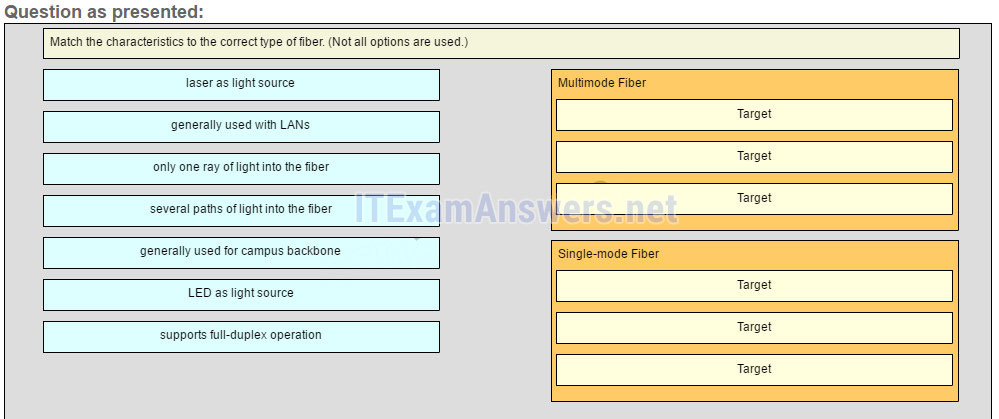
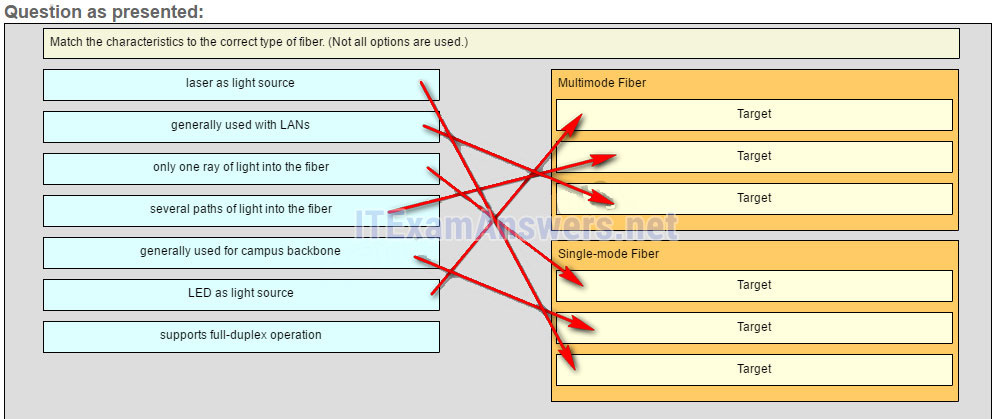
Multimode Fiber
LED as light source*
several paths of light into the fiber*
generally used with LANs*
Single-mode Fiber
only one ray of light into the fiber*
generally used for campus backbone*
laser as light source*


Multimode Fiber
LED as light source*
several paths of light into the fiber*
generally used with LANs*
Single-mode Fiber
only one ray of light into the fiber*
generally used for campus backbone*
laser as light source*
26. Fill in the blank.
A physical topology that is a variation or combination of a point-to-point, hub and spoke, or mesh topology is commonly known as a hybrid topology.
A physical topology that is a variation or combination of a point-to-point, hub and spoke, or mesh topology is commonly known as a hybrid topology.
27. What are two examples of hybrid topologies? (Choose two.)
- point-to-point
- partial mesh*
- extended star*
- hub and spoke
- full mesh
Other Quetions
28. Which statement describes signaling at the physical layer?
- Sending the signals asynchronously means that they are transmitted without a clock signal.*
- In signaling, a 1 always represents voltage and a 0 always represents the absence of voltage.
- Wireless encoding includes sending a series of clicks to delimit the frames.
- Signaling is a method of converting a stream of data into a predefined code
29. The throughput of a FastEthernet network is 80 Mb/s. The traffic overhead for establishing sessions, acknowledgments, and encapsulation is 15 Mb/s for the same time period. What is the goodput for this network?
- 15 Mb/s
- 95 Mb/s
- 55 Mb/s
- 65 Mb/s*
- 80 Mb/s
30. How is the magnetic field cancellation effect enhanced in UTP cables?
- by increasing the thickness of the PVC sheath that encases all the wires
- by increasing and varying the number of twists in each wire pair*
- by increasing the thickness of the copper wires
- by decreasing the number of wires that are used to carry data
31. Which statement is correct about multimode fiber?
- Multimode fiber cables carry signals from multiple connected sending devices.
- Multimode fiber commonly uses a laser as a light source.
- SC-SC patch cords are used with multimode fiber cables.*
- Multimode fiber has a thinner core than single-mode fiber..
32. A network administrator is required to upgrade wireless access to end users in a building. To provide data rates up to 1.3 Gb/s and still be backward compatible with older devices, which wireless standard should be implemented?
- 802.11n
- 802.11ac*
- 802.11g
- 802.11b
33. What is one main characteristic of the data link layer?
- It generates the electrical or optical signals that represent the 1 and 0 on the media.
- It converts a stream of data bits into a predefined code.
- It shields the upper layer protocol from being aware of the physical medium to be used in the communication.*
- It accepts Layer 3 packets and decides the path by which to forward a frame to a host on a remote network.
34. What are two characteristics of 802.11 wireless networks? (Choose two.)
- They use CSMA/CA technology.*
- They use CSMA/CD technology.
- They are collision-free networks.
- Stations can transmit at any time.
- Collisions can exist in the networks.*
35. What is the purpose of the FCS field in a frame?
- to obtain the MAC address of the sending node
- to verify the logical address of the sending node
- to compute the CRC header for the data field
- to determine if errors occurred in the transmission and reception*
36. Fill in the blank with a number.
10,000,000,000 b/s can also be written as 10 Gb/s.
10,000,000,000 b/s can also be written as 10 Gb/s.
37. Match the steps to the physical layer operations that occur when data is sent from one node and received at another node.
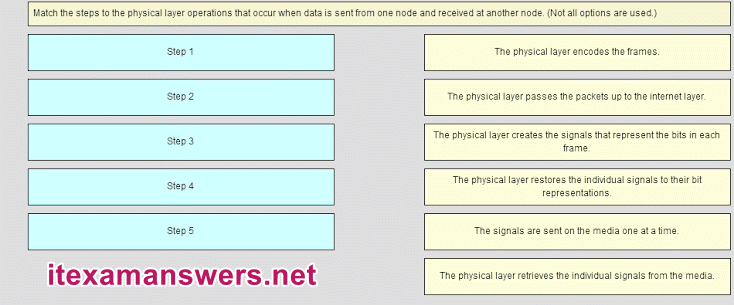
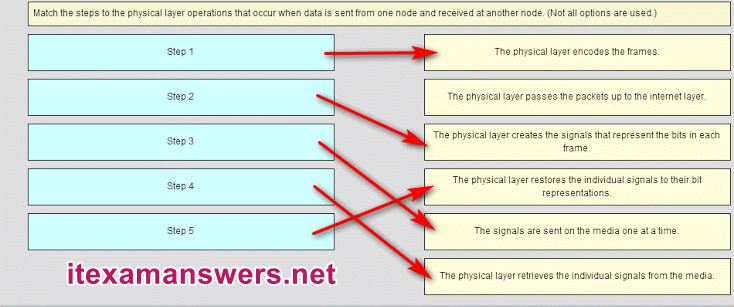
Sort elements
The physical layer encodes the frames -> Step 1*
The physical layer creates the signals that represent the bits in each frame -> Step 2*
The signals are sent on the media one at a time. -> Step 3
The physical layer retrieves the individual signals from the media -> Step 4
The physical layer restores the individual signals to their bit representations -> Step 5*


Sort elements
The physical layer encodes the frames -> Step 1*
The physical layer creates the signals that represent the bits in each frame -> Step 2*
The signals are sent on the media one at a time. -> Step 3
The physical layer retrieves the individual signals from the media -> Step 4
The physical layer restores the individual signals to their bit representations -> Step 5*
38. Refer to the exhibit.
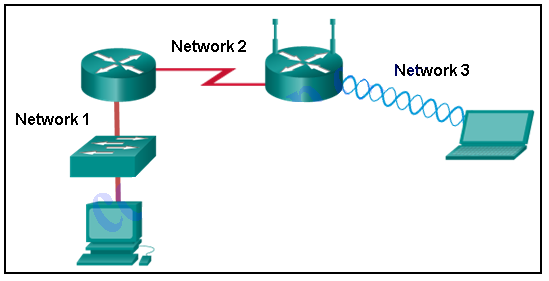
Which statement describes the media access control methods that are used by the networks in the exhibit?
All three networks use CSMA/CA
None of the networks require media access control.
Network 1 uses CSMA/CD and Network 3 uses CSMA/CA.**
Network 1 uses CSMA/CA and Network 2 uses CSMA/CD.
Network 2 uses CSMA/CA and Network 3 uses CSMA/CD.

Which statement describes the media access control methods that are used by the networks in the exhibit?
All three networks use CSMA/CA
None of the networks require media access control.
Network 1 uses CSMA/CD and Network 3 uses CSMA/CA.**
Network 1 uses CSMA/CA and Network 2 uses CSMA/CD.
Network 2 uses CSMA/CA and Network 3 uses CSMA/CD.
CCNA 1 v6 - Chapter 4 Exam Answers 2019 – 100% Full
 Reviewed by Mouad
on
07:27:00
Rating:
Reviewed by Mouad
on
07:27:00
Rating:
 Reviewed by Mouad
on
07:27:00
Rating:
Reviewed by Mouad
on
07:27:00
Rating:




Aucun commentaire: